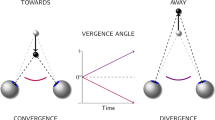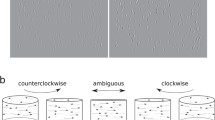Abstract
The relationship between disparity and ocular vergence was investigated under closed-loop as well as under open-loop viewing conditions. First we examined whether vergence responded similarly to disparity presented under open-loop and closed-loop conditions. Similar response were observed in both conditions. The direct relationship between disparity and vergence was examined by presenting constant disparities between 0.2° and 4° under open-loop viewing conditions. Such vergence responses are described as the outputs of first-order low-pass filters with different filter characteristics for each amplitude of disparity. By analyzing the latency of vergence responses induced by constant disparities with help of the transfer function of disparitycontrolled vergence, the time delay of disparity processing in the vergence loop was estimated. We suggested that the time delay was approximately between 80 and 120 ms instead of 160 ms as is generally assumed. The relationship between the rate of disparity change and vergence was examined by comparing responses to ramp and stepwise changes in target vergence. From the similar responses to ramp and staircase changes in disparity we concluded that vergence is not sensitive to the velocity of target vergence as such. On the basis of these findings we developed a model of disparity-controlled vergence. In this model disparity is processed through several parallel, imperfect integrators with slightly different low-pass filter characteristics, each of them susceptible to a limited range of disparities. Gains as well as phase lags of vergence responses to sinusoidal disparities are accurately simulated by this model. As a consequence of the limited working range of the low-pass filters, the model correctly simulates the alterations of fast and slow phases in response to step and ramps of target vergence, which are characteristic of real vergence responses.
Similar content being viewed by others
References
Collewijn H, Tamminga EP (1986) Human fixation and pursuit in normal and open-loop conditions: effects of central and peripheral retinal targets. J Physiol 379:109–129
Collewijn H, Van der Mark F, Jansen TC (1975) Precise recording of human eye movements. Vision Res 15:447–450
Cumming BG, Judge SJ (1986) Disparity-induced and blur-induced convergence eye movement and accommodation in the monkey. J Neurophysiol 55:896–914
Cushman WB, Tangney JF, Steinman RM, Ferguson JL (1984)Characteristics of smooth eye movements with stabilized targets. Vision Res 24:1003–1009
Erkelens CJ (1987) Adaptation of ocular vergence to stimulation with large disparities. Exp Brain Res 66:507–516
Erkelens CJ, Collewijn H (1985) Eye movements and stereopsis during dichoptic viewing of moving random-dot stereograms. Vision Res 25:1689–1700
Hung GK, Semmlow JL, Ciuffreda KJ (1986) A dual mode dynamic model of the vergence eye movement system. IEEE Trans Biomed Eng BME-33:1021–1028
Julesz B (1978) Global stereopsis: cooperative phenomena in stereoscopic depth perception. In: Held R, Leibowitz HW, Teubner H-L (eds) Handbook of sensory physiology, vol VIII. Springer, Berlin Heidelberg New York, pp 215–264
Krishnan VV, Stark L (1977) A heuristic model for the human vergence eye movement system. IEEE Trans Biomed Eng BME-24:44–49
Rashbass C (1981) Reflexions on the control of vergence. In: Zuber BL (eds) Models of oculomotor behavior and control. CRC Press, Boca Raton, pp 139–148
Rashbass C, Westheimer G (1961) Disjunctive eye movements. J Physiol 159:339–360
Robinson DA (1963) A method of measuring eye movements using a scierai search coil in a magnetic field. IEEE Trans Biomed Electr BME-10:137–145
Robinson DA (1973) Models of the saccadic eye movement control system. Kybernetik 14:71–83
Schor CM (1979) The relationship between fusional vergence and fixation disparity. Vision Res 19:1359–1367
Schor CM (1980) Fixation dispersity: a steady state error of disparity-induced vergence. Am J Optom Physiol Opt 57:618–631
Semmlow JL, Hung GH, Ciuffreda KJ (1986) Quantitative assessment of disparity vergence components. Invest Ophthalmol Vis Sci 27:558–565
Van den Berg AV, Collewijn H (1989) Human smooth pursiut during transient perturbations of predictable and unpredictable arget motions. Exp Brain Res 72:95–108
Westheimer G, Mitchell G (1956) Eye movement responses to convergent stimuli. Am Arch Ophthalmol 55:848–856
Zuber BL, Stark L (1968) Dynamical characteristics of the fusional vergence eye movement system. IEEE Trans Syst Sci Cybern SSC-4:72–79
Author information
Authors and Affiliations
Rights and permissions
About this article
Cite this article
Pobuda, M., Erkelens, C.J. The relationship between absolute disparity and ocular vergence. Biol. Cybern. 68, 221–228 (1993). https://doi.org/10.1007/BF00224855
Received:
Accepted:
Issue Date:
DOI: https://doi.org/10.1007/BF00224855




